How to connect to eduroam
Use the guides below to connect to WiFi on any device. If you have any issues, you can use the chat window on this page to contact IT Support or find about more about getting IT support.
Choose an operating system
- Windows 11 WiFi settings can be found from the Network and Volume section of the task bar.
Select it to bring up a selection of controls and toggle on the WiFi, if not already on, then click the right arrow next to it to display the current list of available networks.
- Select eduroam, tick Connect automatically then select Connect
- Enter your network account username with @port.ac.uk, e.g. bloggsj@port.ac.uk followed by your password, then select OK
- You should now be connected to the wireless network.
A video demonstration can be viewed below.
1. Select the network icon in the system tray on the right, eduroam should be listed as an available.
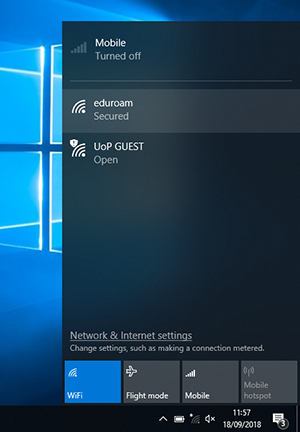
2. Select eduroam, tick Connect automatically then select Connect
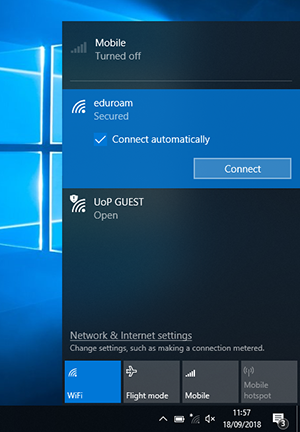
3. Enter your network account username with @port.ac.uk e.g. bloggsj@port.ac.uk followed by your password, then select OK
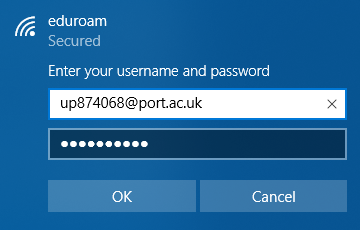
4. If you are prompted by a message asking you to confirm you want to continue connecting, choose Connect
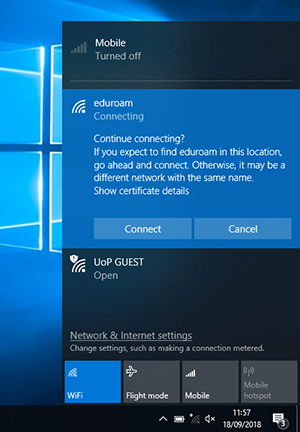
5. You should now be connected to the wireless network.
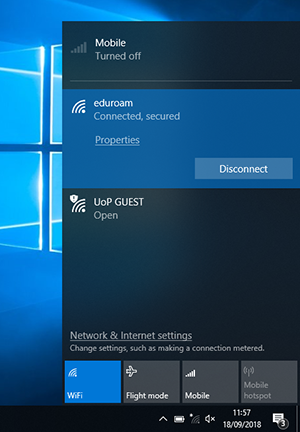
1. Click the Wireless icon on the Finder bar, select eduroam
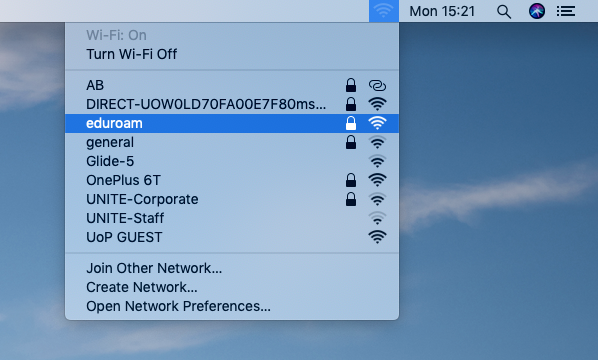
2. Enter your University computer account username@port.ac.uk, e.g. bloggsJ@port.ac.uk and your University computer account password then click Join
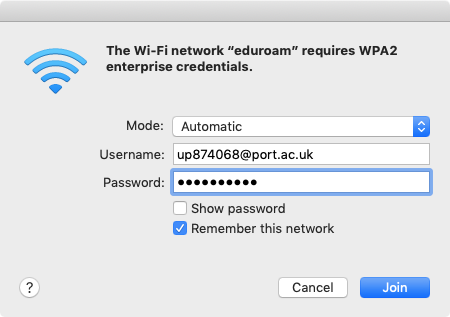
3. If you are prompted with a message regarding verifying the certificate, click Continue

4. Enter your admin username and password then Update Settings
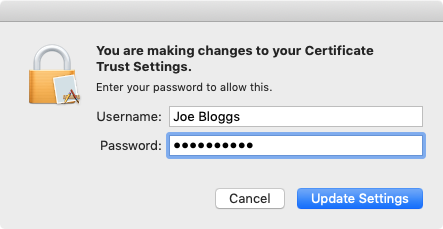
5. The wireless icon in the Finder bar should show as connected.
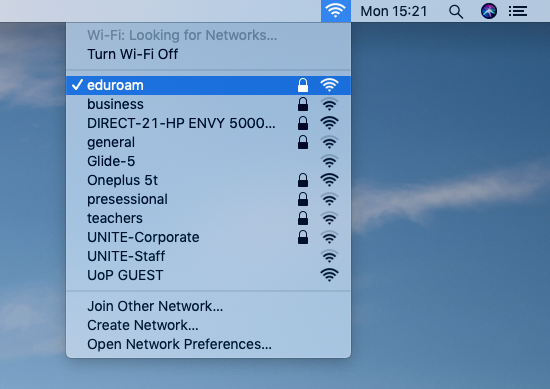
1. Tap Settings then Wi-Fi. Any available wireless networks networks will be listed, tap eduroam.
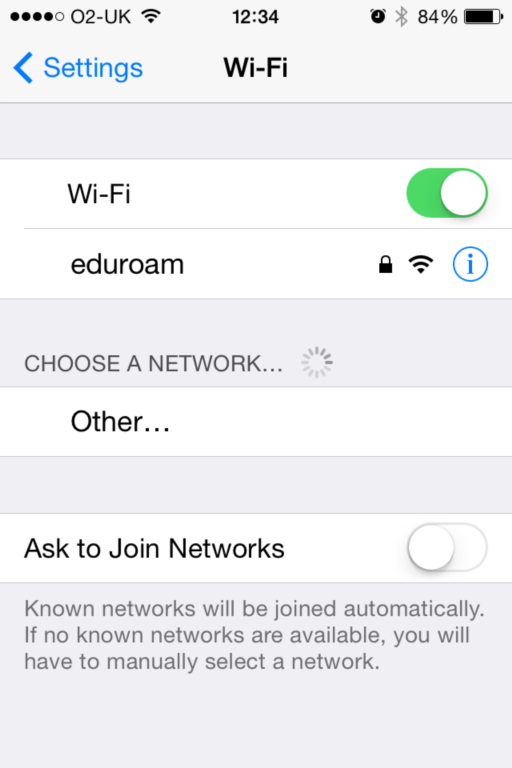
2. You will be prompted to enter your computer account username followed by @port.ac.uk and password e.g. bloggsj@port.ac.uk then tap Join.
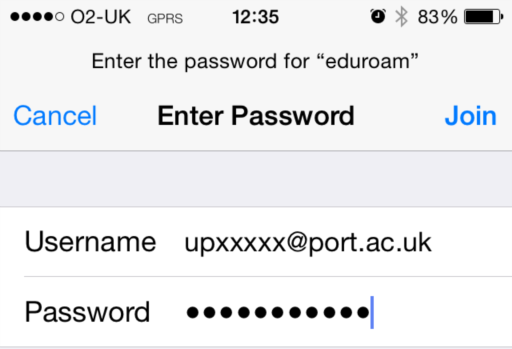
Please note some older Android versions are incompatible with the eduroam wireless network.
- Open the device's Settings menu and select WiFi
- Select eduroam on the list of available networks
- Set EAP method to PEAP
- Set Phase-2 authentication to MSCHAPv2
- Set CA Certificate to Use system certificates
- Select Do Not Validate
- Enter port.ac.uk in the Domain field (if required)
- Enter your student or staff network username (PC Login Username) in the Identify field (add @port.ac.uk as part of the name e.g up874068@port.ac.uk / smithj@port.ac.uk)
- If using an Android 14 device set Anonymous Identity to = [username]@port.ac.uk e.g. up1234567@port.ac.uk
- In the Password field, enter your network password. Then select Connect at the bottom right of the screen
- eduroam will automatically connect every time you are within range of the wireless network
- Select the network icon from the top right hand corner of your screen Scan for wireless networks and select eduroam
- Use the following settings:
- SSID = eduroam
- Security type = PEAP
- Security method = mschapv2
- CA = leave as default
- ID = University username@port.ac.uk eg. bloggsj@port.ac.uk
- Password = University password (case sensitive)
These settings have been tested on CentOS 7.4
1. Navigate to the network-manager from the menu on the top right, and choose Wi-Fi Settings
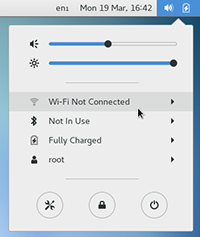
2. Select the eduroam network
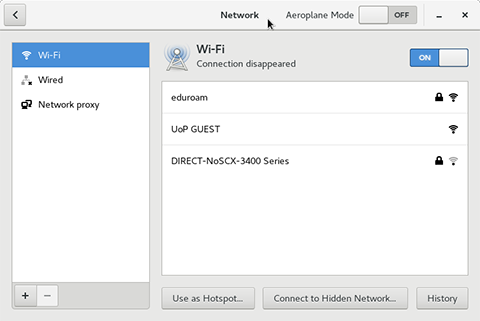
3. Configure settings as per screenshot below:
- Wi-fi security: WPA & WPA2 Enterprise
- Authentication: Protected EAP (PEAP)
- CA certificate: No CA certificate is required ticked
- PEAP version: Automatic
- Inner authentication: MSCHAPv2
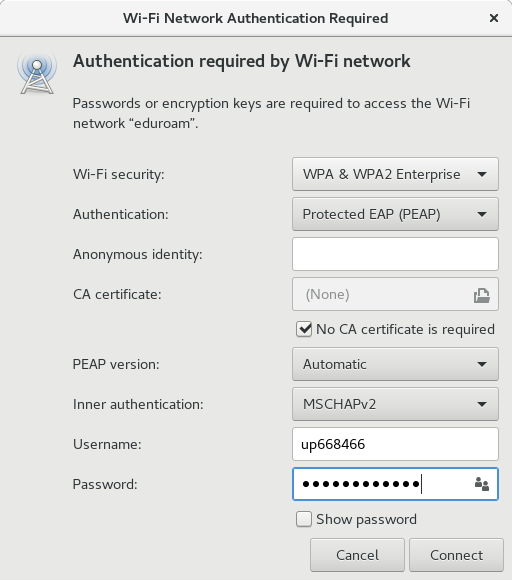
4. Click connect
Connecting to eduroam at other institutions
Working onsite
If you are using eduroam on site, you do not need to do anything, you will connect automatically. eduroam will be displayed in your system tray as eduroam (UoP Computer)
Using eduroam offsite
If you are visiting another eduroam location, we recommend you set up your connection beforehand, you will only need to do this once.
Setting up offsite eduroam:
- Click on wifi on the system tray
- Choose eduroam (uop user) - view image
- Enter your email address and password
- Click on OK
Using eduroam offsite
If you are working off site and do not connect automatically
- Click on wifi on the system tray
- Choose eduroam (UoP user) view image you will not be prompted to login if you have already set this up
You can use your university email address to connect to eduroam WiFi networks at many other universities and institutions across the world. If you're travelling to another campus, see the full list of participating institutions to make sure you can connect when you get there.
Staff laptops at other institutions
Staff using Windows 10 laptops will need to log into their laptop with the suffix @uni.ds.port.ac.uk after their username to connect to an eduroam connection off-site.
You can sign in with username@uni.ds.port.ac.uk on campus or at any location where an eduroam wireless connection is available. Adding the suffix will still use your normal account so all of your files and folders will be available. You can log in on campus with or without the the full username as both options will work. To do this:
- If you are not at the log in screen, log out.
- Log in with your username@uni.ds.port.ac.uk (not @port.ac.uk as this will not work), e.g. bloggsj@uni.ds.port.ac.uk
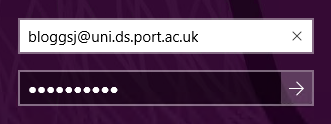
- eduroam should connect.
If eduroam does not connect, you will need to contact the Service Desk with the following information:
- Username
- Location and time of attempted connection
- Whether other devices connect e.g. your phone
- Your laptop make and model
Connecting to eduroam as a visitor
If you're visiting from another institution that uses eduroam, you can log in using the guides above with your username and password from your home institution.
We recommend you connect to eduroam before arriving at the University of Portsmouth, and direct any support queries to your home institution.
Connecting to UoP GUEST
If your friends or family are visiting campus for the day and need to access WiFi, they can connect to the UoP GUEST network using their personal email address.
The GUEST network will give them high-quality WiFi access but guests can't access the intranet and internal applications on this network.
The UoP GUEST network should not be used by staff or students.
WiFi general settings
Below are the general settings for our campus eduroam network, incase you need them to configure a device.
- Wireless network name (SSID) – eduroam
- Operating mode/type – Network (Infrastructure)
- Authentication/association – WPA2 - Enterprise
- Data Encryption – AES
- Authentication type – PEAP
- Authentication protocol – MSCHAP v2
- User credentials/login -–your computer account username@port.ac.uk and normal password
- Roaming identity/login domain – leave blank
- Validate server certificate – AddTrust External CA Root
- Server certificate issuer – wifi.port.ac.uk
- issued by TERENA SSL CA
- verified by UTN-USERFirst-Hardware and AddTrust External CA Root
- TCP/IP protocol – obtain configuration automatically from DHCP server

